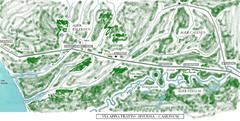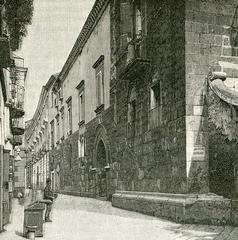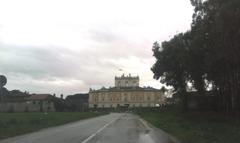
Capua Cathedral: Visiting Hours, Tickets, and Historical Sites in Capua, Italy
Date: 04/07/2025
Introduction
Situated in the historic heart of Capua, Italy, Capua Cathedral—officially Cattedrale di Santa Maria Assunta—is a monumental testament to over fifteen centuries of religious devotion, architectural evolution, and cultural heritage. Its origins trace back to early Christian times, with tradition linking its foundation to St. Priscus, a disciple of Jesus, and the first church established in 432 AD by Bishop St. Symmachus. Over the centuries, the cathedral has undergone medieval transformations, Renaissance artistry, Baroque embellishments, and modern restorations following wartime destruction. Today, visitors encounter a richly layered structure featuring Romanesque, Lombard, Norman, and Baroque elements, highlighted by a remarkable basilica plan with five naves supported by ancient Corinthian columns, and a distinctive bell tower blending Lombard and Norman motifs.
Capua Cathedral is not only a house of worship but also a cultural cornerstone of the city, reflecting its resilience and identity through centuries of religious ceremonies, civic events, and artistic patronage. The cathedral’s interior boasts significant artworks—including masterpieces by Giacinto Diano and Francesco Solimena—medieval frescoes, and sacred relics such as the silver bust of Saint Stephen, Capua’s patron saint. Its crypt preserves early Christian mosaics and frescoes, forging a direct link to the dawn of Christianity in the region. Comprehensive guided tours, accessibility features, and proximity to other historic sites, such as the ancient Amphitheatre and Capua Archaeological Museum, enrich the visitor experience.
This guide provides essential information on Capua Cathedral visiting hours, ticketing, architectural highlights, and travel tips, ensuring a fulfilling visit to one of southern Italy’s most treasured landmarks. For further insights and planning, please consult official resources like Ancient Capua, Religiana, and Audiala.
Table of Contents
- Early Christian Foundations and Legendary Origins
- Medieval Transformations and Architectural Evolution
- Renaissance and Baroque Renovations
- 19th and 20th Century Restorations
- Architectural Features and Artistic Heritage
- Religious and Civic Significance
- Visitor Information
- Visuals and Media
- Frequently Asked Questions (FAQ)
- Related Articles
- Conclusion
- References
Early Christian Foundations and Legendary Origins
Capua Cathedral’s origins are entwined with the earliest days of Christianity in Italy. Tradition holds that its Christian community was founded by St. Priscus, a disciple of Jesus, possibly arriving with Saint Peter in the 1st century AD (Ancient Capua). The original basilica, constructed in 432 AD by Bishop St. Symmachus, was built atop the crypt of St. Priscus. Legends add further intrigue, including stories of Pope Adrian I discovering a Latin inscription near the altar that promised spiritual purification to dawn visitors during August, and tales of miraculous healings associated with the site.
Medieval Transformations and Architectural Evolution
The cathedral was extensively rebuilt and expanded in the Middle Ages. While some sources attribute the current structure’s founding to Bishop Landulfo in 856 AD, significant reconstructions followed, especially under Archbishop Erveo (1072–1086), who added the entrance portico and oversaw renovations of the bishop’s palace (Religiana). The 10th and subsequent centuries saw further enhancements, reflecting the evolving political, religious, and artistic climate of southern Italy.
The Romanesque core is evident in strong masonry and rounded arches, while the bell tower—featuring three tiers of double lancet windows and ancient reused columns—displays both Lombard and Norman influences (Italy This Way). Reused Roman columns throughout the nave and crypt (spolia) symbolize the continuity between Capua’s ancient and Christian heritage (Wikipedia; Audiala).
Renaissance and Baroque Renovations
The Renaissance and Baroque periods saw the cathedral’s expansion, with the 15th-century enlargement of the entrance portico and the addition of new chapels and artistic works. The 18th century brought a substantial Baroque renovation, introducing ornate altars, stucco decorations, and vibrant frescoes that enriched the cathedral’s interior (Religiana).
19th and 20th Century Restorations
Between 1854 and 1857, a major restoration was conducted by architect Federico Travaglini under Bishop Giuseppe Cosenza. Catastrophic damage during World War II—caused by Allied bombing in 1943—necessitated a comprehensive reconstruction from 1949 to 1957, blending historical fidelity with modern building methods (Religiana). In 1992, a Diocesan Museum was established in a chapel, showcasing liturgical objects, artworks, and archaeological finds (Wikipedia).
Architectural Features and Artistic Heritage
- Plan and Columns: The cathedral’s rare five-nave basilica layout is supported by over 50 ancient columns with Corinthian capitals, many repurposed from Roman structures (Ancient Capua).
- Artistic Treasures: Notable works include Giacinto Diano’s “L’Assunzione della Vergine” and paintings by Francesco Solimena (Italy This Way; Audiala).
- Crypt and Relics: The crypt offers early Christian mosaics and frescoes, while the main altar and side chapels display sacred relics, including the silver bust of Saint Stephen (Campania Artecard).
- Baroque and Medieval Elements: Baroque altars, medieval candleholders, and polychrome marble features illustrate centuries of religious art (Italy This Way).
Religious and Civic Significance
Capua Cathedral has served as the city’s spiritual heart, hosting major liturgical celebrations, civic events, and community gatherings. Its role as the seat of the Archdiocese of Capua since the Middle Ages cements its place in regional religious history. The annual Feast of Saint Stephen and other festivals draw pilgrims and reinforce Capua’s cultural identity (Visit Italy).
The cathedral’s archives hold invaluable historical records, while its adjacent museum presents vestments, manuscripts, and sacred art (Campania Artecard). The cathedral also engages in interfaith dialogue and educational outreach, playing a key role in Capua’s community life.
Visitor Information
Visiting Hours
- Monday to Saturday: 9:00 AM – 12:30 PM and 3:00 PM – 6:00 PM
- Sunday: 10:00 AM – 12:30 PM and 4:00 PM – 7:00 PM
- Note: Hours may vary during religious festivals or special events. Always check the official diocesan website for up-to-date information.
Tickets and Admission
- General Admission: Free
- Guided Tours & Museum: May require tickets or advance booking. Inquire onsite or through the official website.
Accessibility
- The main entrance features a ramp and step-free access to most areas.
- Some historic sections (crypt, upper bell tower) may have limited accessibility.
Guided Tours and Special Events
- Guided tours provide historical and artistic insights and often include the crypt, bell tower, and museum. Advance booking is suggested, especially for groups or during peak seasons (Audiala).
- The cathedral hosts concerts, art exhibitions, and regional festivals throughout the year (FAI).
Dress Code and Etiquette
- Modest dress is required (shoulders and knees covered, hats removed).
- Photography is allowed (no flash); silence and reverence are expected.
Getting There
- The cathedral is centrally located, easily reached by foot from the train station, bus stops, and nearby parking.
- The surrounding area offers cafes, shops, and other amenities.
Nearby Attractions
- Ancient Roman Amphitheatre: Italy’s second largest (source)
- Museo Campano: Archaeological and historical collections
- Historic city center: Medieval walls, bridges, and churches
Visuals and Media
Enhance your visit with high-quality images and virtual tours available on the official website and heritage portals. Suggested alt tags for images:
- “Capua Cathedral Romanesque façade”
- “Interior with ancient columns”
- “Crypt mosaics and frescoes”
- “Silver bust of Saint Stephen procession”
Frequently Asked Questions (FAQ)
Q: What are Capua Cathedral’s visiting hours?
A: Monday to Saturday 9:00 AM–12:30 PM & 3:00 PM–6:00 PM; Sunday 10:00 AM–12:30 PM & 4:00 PM–7:00 PM. Hours may vary—check official sources.
Q: Is there an admission fee?
A: General admission is free; some tours or museum areas may require a ticket.
Q: Are guided tours available?
A: Yes, often including the crypt, bell tower, and museum. Advance booking recommended.
Q: Is the cathedral accessible for people with disabilities?
A: Most main areas are accessible; some historic sections have limited access.
Q: Can I take photographs?
A: Photography is generally permitted, but no flash and always respect ongoing services.
Q: What other sites are nearby?
A: The Roman amphitheater, Museo Campano, city walls, and historic piazzas.
Related Articles
Conclusion
Capua Cathedral is a remarkable synthesis of history, art, and spirituality. Its layered architecture, artistic treasures, and religious significance make it a must-visit destination in southern Italy. With free admission, accessible facilities, and engaging tours, the cathedral welcomes all visitors—offering a vibrant experience at the crossroads of ancient and modern Capua. For a complete experience, explore nearby historic sites, attend a festival or concert, and immerse yourself in Capua’s living traditions.
To plan your visit, always consult official resources for updated hours and events. Enhance your journey with digital guides like the Audiala app, and connect with Capua’s enduring legacy.
References
- Ancient Capua
- Religiana
- Wikipedia
- Italy This Way
- Audiala
- Campania Artecard
- Visit Italy
- FAI
- The Tourist Checklist
- Italiani.it
- Tourist Places Guide



